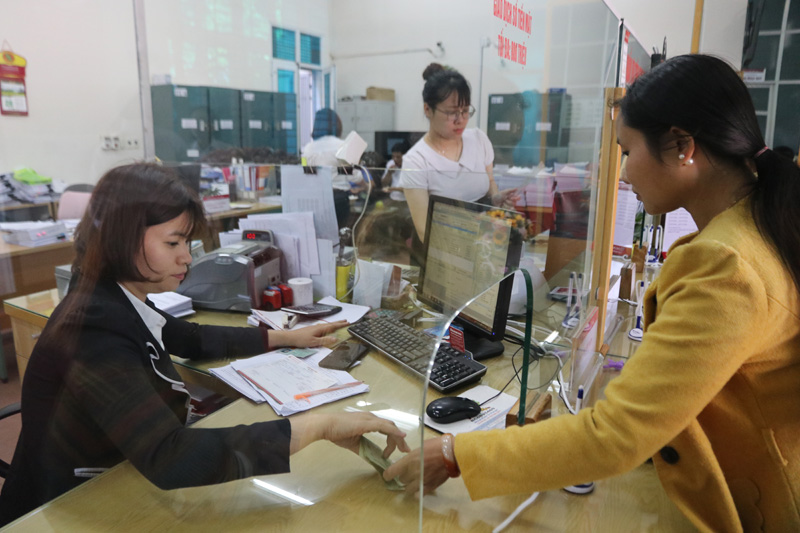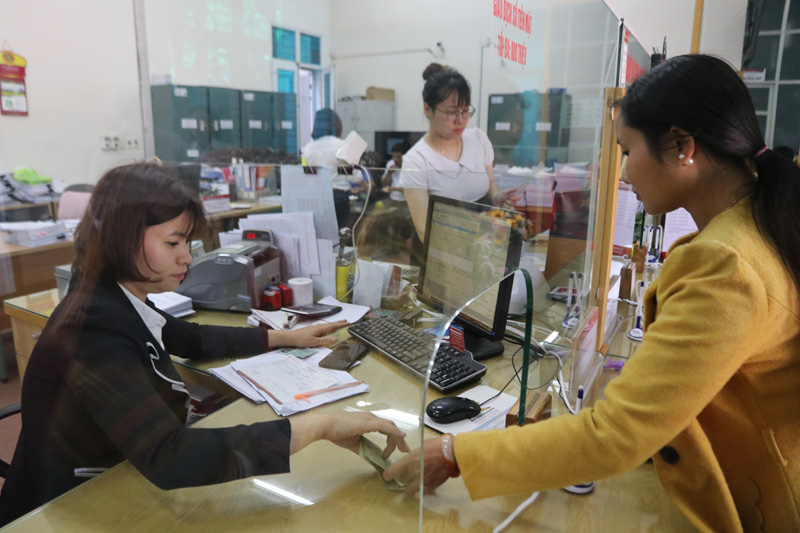
(HBO) – In the face of the COVID-19 pandemic’s impact on many economic sectors, some commercial banks in Hoa Binh province have decided to extend debt payment deadlines, not charge interest on late payments, and assist people and businesses to access preferential loans to overcome difficulties.
 The
Agribank branch in Cao Phong district has created favourable conditions for
clients to take out loans as the COVID-19 outbreak has hampered production and
business activities.
The
Agribank branch in Cao Phong district has created favourable conditions for
clients to take out loans as the COVID-19 outbreak has hampered production and
business activities.
Since the year’s beginning, the COVID-19
outbreak has greatly affected the operation of local enterprises and business
households.
A homestay facility owner in Lac village of Chieng Chau commune, Mai Chau district,
said there are about 60 homestays receiving domestic and foreign visitors in
the village at present. However, the epidemic has forced many of them to shut down
and discouraged tourists to visit here.
Nguyen Anh Tuan, Director of the MBBank’s Hoa
Binh branch, noted it has more than 30 individual clients with loans of about 5
billion VND (211,800 USD) in Hoa Binh. His branch has built plans to support
them. It has also reviewed business borrowers that operate in the fields of
hospitality, transportation and trading of goods with China so as to
provide assistance such as cutting interest rates or extending debt payment
deadlines.
According to the provincial branch of the State
Bank of Vietnam (SBV), outstanding loans in Hoa Binh totaled nearly 22.68
trillion VND through the end of February, rising by just 0.2 percent from late
2019. The sum consists of nearly 9.3 trillion VND in short-term loans and 13.38
trillion VND in medium- and long-term loans, respectively accounting for 41
percent and 59 percent of the total.
Deputy Director of the branch Ngo Quang Loi said
to carry out the SBV’s monetary policy and directions, his branch has instructed
credit organisations to keep track of the production – business situation and
losses of their clients due to COVID-19’s impact, especially sectors vulnerable
to the pandemic like tourism, agriculture and import-export, so as to take
timely measures to help them address difficulties. At the same time, it is also
working to meet the capital demand of feasible production and business plans
and prioritise capital for agriculture and rural development./.
Since the beginning of this year, under the direction of the Department of Agriculture and Environment, the Sub-Department of Agricultural, Forestry, and Fishery Product Quality Management has strengthened the integration of the professional activities to promote and guide the organizations and individuals in the production and trading of agricultural, forestry, and fishery products to comply with the legal regulations regarding the use of chemicals, pesticides and veterinary medicines in crop cultivation, livestock farming and aquaculture. They also provide guidance to processing and manufacturing establishments on keeping the records to trace the product origins and using food additives from the approved list according to the regulations.
Hoa Binh province saw a significant rise in state budget revenue in the first two months of 2025, heard a meeting chaired by Vice Chairman of the provincial People’s Committee Quach Tat Liem.
Ha Thi Ha Chi, a 26-year-old graduate in law, has taken an unconventional path by returning to her hometown in Mai Chau district to establish the Tong Dau Cooperative, creating stable jobs for local women and bringing Thai ethnic brocade weaving to the global market.
As the Lunar New Year 2025 approached, pork prices surged, creating a profitable season for farmers in Tan Vinh commune, Luong Son district. Taking advantage of the rising demand, Can Minh Son, a farmer from Coi hamlet, sold over 30 pigs at 69,000 VND/kg, each weighing more than 100 kg. After deducting expenses, his family earned a profit of over 50 million VND.
alternate member of the Central Party Committee, Secretary of the Hoa Binh provincial Party Committee Nguyen Phi Long on March 5 had a working session with Yan Jiehe, Founder and Chairman of the China Pacific Construction Group, one of China's largest private corporations in the field of transport infrastructure. Deputy Secretary of the provincial Party Committee, Chairman of the provincial People's Committee Bui Duc Hinh and leaders of provincial departments and sectors also attended the working session.
The electronic printed circuit board (PCB) manufacturing and processing plant of Japan’s Meiko Group, located at Da River Left Bank Industrial Park in Hoa Binh city with a total investment of over 200 million USD, is expected to create thousands of jobs and make a significant contribution to the local budget.



 The
Agribank branch in Cao Phong district has created favourable conditions for
clients to take out loans as the COVID-19 outbreak has hampered production and
business activities.
The
Agribank branch in Cao Phong district has created favourable conditions for
clients to take out loans as the COVID-19 outbreak has hampered production and
business activities.